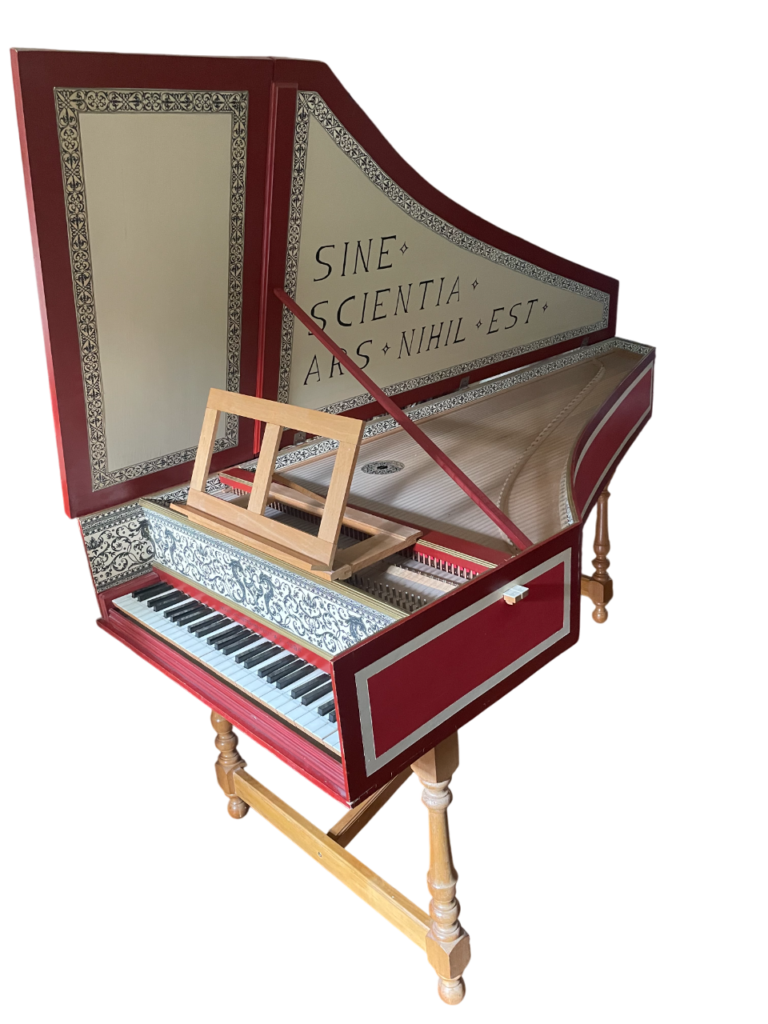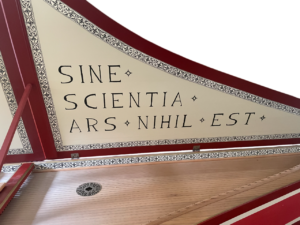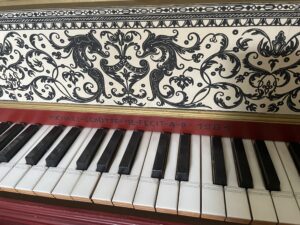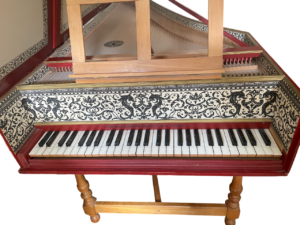Michael Schütte – Zuckermann after Flemish models 1984
Description

| Date: | 1984 |
| Origin: | Germany |
| Serialnumber: | --- |
The Harpsichord in Flanders – Centre of a European Ideal of Sound
From the late 16th century well into the 18th century, Flanders played a central role in the development of harpsichord building and keyboard music. In particular, the workshops of the Ruckers family in Antwerp established a building tradition whose tonal and structural principles had an enduring impact far beyond the region itself. Their instruments were distinguished by a clear, resonant tone, precise articulation and a balanced overtone spectrum – characteristics that came to define the so-called “Flemish sound” and served as a benchmark for subsequent generations of harpsichord makers.
The Ruckers harpsichords, often conceived as single-manual instruments with 4′ and 8′ or 8’ and 8’ registers, were also noted for their robust construction, linear scaling, and their striking, architecturally austere aesthetic. Their richly decorated lids, featuring emblematic imagery, floral arabesques and Latin mottoes, were an expression of both humanist learning and Baroque culture of representation. During the 17th century, many of these instruments were modified through so-called ravalements – particularly in France – to meet evolving tonal and technical demands.
Parallel to this flourishing of instrument making, a distinctive repertoire also emerged. Composers such as Pieter Cornet, Jan Pieterszoon Sweelinck, and later Jacques Duphly (whose family originated from Flanders) combined contrapuntal heritage with idiomatic keyboard writing. The influence of Franco-Flemish vocal polyphony remained noticeable for a long time, though it was increasingly overlaid by French ornamentation and dance forms. The toccatas, fantasias and variation cycles of Flemish origin, in particular, demonstrate a deep understanding of the harpsichord as an independent artistic medium.
The Flemish harpsichord tradition is therefore not only a milestone in the history of instrument making, but also a key to the aesthetic and stylistic diversity of European keyboard music before 1750.
An Instrument after Flemish Models
This single-manual harpsichord, based on Flemish models, comes from the workshop of Wolfgang Zuckermann and was built in 1984 by Michael Schütte with great craftsmanship. It was constructed following historical principles. The case, in a square wing form, is made of cedarwood and features ornate brass hinges and contrasting panels in various shades of red. The interior is lined with Flemish-style wallpaper, and the inside of the lid bears the inscription:
“Sine scientia ars nihil est”
(Without knowledge, art is nothing)

Harpsichord made by Michael Schütte in 1984 after Flemish Models (4) – Eric Feller Collection
Above the keyboard is the signature:
“Michael Schütte me fecit A.D. 1984”
The keyboard is made of ivory and rosewood, the soundboard of spruce, with a carved rose in the centre. The instrument has two 8′ registers, a lute stop, two sets of jacks and Delrin plectra. It rests on a Flemish-style wooden stand with decorative elements. The sound of the instrument is dark and lyrical, offering a rich palette of tonal colours.

Harpsichord made by Michael Schütte in 1984 after Flemish Models (3) – Eric Feller Collection
With the rise of the historical performance movement, the demand for harpsichords increased. Firms such as Neupert and Sperrhake produced instruments largely built in the modern “Rastenbauweise” (frame construction method), incorporating many elements of modern piano making – though they had little in common with historical harpsichords in terms of tone and construction. Historically accurate copies were rare and expensive. Wolfgang Zuckermann recognised this gap in the market and, in the late 1950s, began offering affordable kits for harpsichords built along historical lines in the United States. These kits were (and still are) available in different levels of completeness, allowing customers to build their own harpsichord at relatively low cost. However, these self-built harpsichords have always reflected the abilities of their individual makers.
Wolfgang Zuckermann (1922–2018)
Wolfgang Zuckermann was born in Berlin on 11 October 1922. Due to the family’s Jewish faith, he fled with his parents to the United States in 1938. After training as a child psychologist, he turned his attention to harpsichord building and, in the 1950s, began selling harpsichord kits based on historical models. In 1969, he sold his company (which continues to operate internationally under different ownership) and moved to England. In 1995, he settled in Avignon, France. He authored two books on harpsichord building:
- The Modern Harpsichord. October House, 1969
- The Modern Harpsichord: Twentieth Century Instruments and Their Makers. Reprint Services Corp, 1986
Wolfgang Zuckermann passed away on 3 November 2018.

Harpsichord made by Michael Schütte in 1984 after Flemish Models (2) – Eric Feller Collection
| Length: | 209 cm |
| Width: | 84 cm |
| Height: | 25 cm |
| Circumference: | 4 3/4 octaves (GG – d3) |
| Mechanics: | plastic jacks with delrin quills |
| Pedals: | Registers: 8' and 8', lute stop |
| Signature: | „Michael Schütte me fecit A. D. 1984“ |

